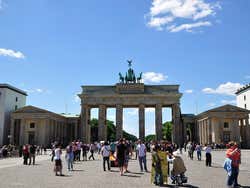
Brandenburg Gate
The Brandenburg Gate was once a city gate into Berlin. Nowadays, it is one of the most important symbols of Berlin and an emblem of peace.
The Brandenburg Gate, (Brandenburger Tor in German) is a former city gate to Berlin, as well as a major symbol of the capital city.
Designed in 1791 close to the Pariser Platz, in the center of Berlin, it is one of the most renowned monuments of Berlin.
The neoclassical gate stands 26 meters high and was inspired by the Acropolis of Athens.
In 1795 the monument was crowned with a chariot drawn by four horses heading into the city, known as the Quadriga. The bronze statue represents the Goddess of Victory. The original sculpture was destroyed during World War II, so it was replaced by an exact replica made in West Germany in 1969.
The Gate is held up by twelve columns with five passageways. From its inauguration until 1918, the central access was exclusively for the members of the German Royal Family and members of the Bourgeoisie.
Pride and Drama
Since it was built, the Brandenburg Gate has always been a site of major events in Berlin, including royal parades, Nazi ceremonies and marches by Napoleon and his troops.
The Brandenburg Gate had been untouched until World War II, causing great damage to the structure and ruining the Quadriga.
In 1956, the East and West joined together to rebuild the landmark. Several years later, in 1961, the Soviet Union built the Berlin Wall and the Gate stood between both parts, with little access to it.
When the city was reunified, the Brandenburg Gate finally regained the importance it was once given.
Beautiful During the Day and at Night
The Brandenburg Gate is one of the most important monuments of Berlin and it offers one of the best views of the city. Tourists gather at the foot of the Gate to take the most representative picture of the holiday.
Situated in the city center, the Gate is very near other essential sights like Potsdamer Platz, Pariser Platz and the German Bundestag.


Nearby places
Pariser Platz (103 m) Memorial to the Murdered Jews of Europe (267 m) German Parliament (288 m) Potsdamer Platz (771 m) Unter den Linden (909 m)
